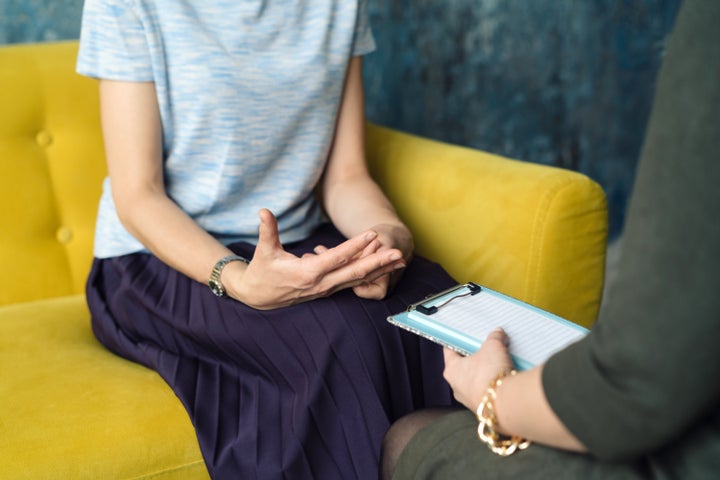
My friends used to tell me all the time, ”maybe you should talk to someone.” While I appreciated their concerns, I could never actually fathom the idea of going to therapy and sharing my deepest, darkest secrets with a complete stranger.
In my family, our unspoken family rule was that no one and nothing else were allowed in, and we weren’t allowed out. So much so that the thought of sharing such personal details of the most intimate and precious part of myself felt violating and wrong.
I thought I was doing what all Asians were supposed to do — bottle up your feelings and pretend like nothing’s wrong, avoid the problem and don’t rock the boat. I eventually hit my rock bottom and ended up seated on a couch in Santa Monica in front of the woman who was about to change my life forever.
When I was searching for a therapist, I knew that she had to be Korean. There was just no way that a white therapist could understand me and my co-dependent family dynamics. But when I first started my search, all I saw were Christian Korean therapists who reminded me of my parents.
I scoured Psychology Today, opening tabs and tabs of Korean American therapists in LA and closing out everyone who included triggering terms in their bios such as Christian Counseling and Faith Based Counseling. Finally, I landed upon my therapist’s page. There was no mention of religion, and she looked young and relatable. Her fee was high, out of pocket, and her office was on the other side of town, but given what little choice I felt I had, I decided to make the leap and invest in my mental health for the first time.
As I griped about my struggles of growing up in the church, she disclosed that she identified as a Christian herself. My immediate thought was: ”Ugh, she’s going to try and make me go to church.” My grimace must have been noticeable because she followed with: “I don’t include it in my bio because I don’t want to get that kind of reaction from clients.”
Turns out, my therapist isn’t like any of the Korean Christians I grew up with. She is an artist, surfs, practices yoga and taekwondo, and travels. She was also a single mom who put together the broken pieces of her life in a beautiful way that made me admire and look up to her, which was something that I desperately needed at the time. She gave me hope.
She became my role model and my mentor. She taught me the language that I needed to communicate with my parents instead of just talking at each other. She broke down many of my misgivings and assumptions about Christians and Koreans. She is one of the reasons I myself became a therapist.
“For that one hour, I was allowed to be selfish and unapologetic. I was allowed to complain, vent and cry. I was allowed to feel hopeless and anxious. I was allowed to just be.”
I quickly came to realize that therapy is a non-judgment zone. It was the one safe space that I had where every week for just one hour, I was allowed to be myself and let down all the walls I built around me out of survival. I didn’t have to wear the many various masks I wore for my different identities — as the daughter, friend, sister, employee and more. I didn’t have to be so hypervigilant about others’ feelings and about potentially offending or disagreeing with them. For that one hour, I was allowed to be selfish and unapologetic. I was allowed to complain, vent and cry. I was allowed to feel hopeless and anxious. I was allowed to just be.
In my family, love felt like it had to be earned. It was never just handed to me on a silver platter. I had to work for my parents’ praise and affection, and even as I met their standards, their expectations only increased, and I had to work even harder. These unrelenting requirements for validation and acceptance are what make me the people-pleaser that I am today. I am a workaholic and often feel worthless when I’m not being productive because I am used to having to prove my worth.
These toxic relationship dynamics are so normalized in immigrant families that I thought this was just how life is for non-Western cultures — which exacerbated my internalized racism — and that I should just suck it up and be grateful that at least I didn’t have it as bad as my parents. My parents’ primary advice in life was to “pray to God” and that “God will solve all problems.” And if things didn’t get better, according to them, it was because I wasn’t praying hard enough.
It’s no wonder that suicide is the leading cause of death for Asian American and Pacific Islander youth aged 12-19. What’s even more tragic is that there is still a huge stigma against the one thing that may have been able to save them — asking for help.
That’s what seeking therapy is: It’s admitting to yourself that you have a problem and asking for someone’s help to fix it because everything you’ve tried so far just isn’t working. Studies have shown that Asian Americans are three times less likely to seek mental health services than white people and they are the least likely racial group in the U.S. to seek mental health services. Some common barriers preventing Asians from asking for help are trauma, spiritual beliefs, not wanting to burden others, guilt, shame and hopelessness.
“Every single person out there is either reliving cycles of intergenerational trauma or they are the ones breaking the cycle. The latter is a much harder feat — and it’s challenging to do on your own.”
Nonetheless, due to the rise of anti-Asian hate crimes since the start of COVID-19 and especially after the shootings in Atlanta, there has been a drastic increase in demand for therapy for Asian Americans. Crisis Text Line, a free resource for Americans seeking immediate support from volunteers who are trained in mental health, reported at the start of the pandemic that the number of Asian Americans seeking support more than doubled.
Asian Americans seeking therapy have reached out to me from all over the state and country, tirelessly searching for an AAPI therapist that can understand them and their racial trauma and identity issues. Some of them are not open with their families about seeking therapy because they don’t want them to potentially ruin such a pure and personal experience for them, a first in a lifetime for many.
I understand those clients completely. Therapy is a sacred space that doesn’t have to be shared with anyone else. However, I like to tell them that every single person out there is either reliving cycles of intergenerational trauma or they are the ones breaking the cycle. The latter is a much harder feat — and it’s challenging to do on your own.
Breaking cycles within the family require self-awareness, and when the entire system is unaware that there is a problem, it’s difficult to see change. It’s why people become hopeless, stuck and desperate.
Sometimes all it takes is the objective outside perspective of a mental health professional trained in psychology, healthy communication and relationships, and mental and emotional well-being, to help you see things you never noticed before. That’s what therapists do: We help you look for the answers in the right places.
Our parents didn’t have the tools, resources, time and luxury to confront and process the trauma that they inherited from their parents. They were too busy trying to survive and make it in a country that has never been kind to immigrants and people of color to even acknowledge how they felt about it.
Asian Americans are the fastest-growing minority population in the United States. Asians now make up about 7% of the nation’s population and are projected to surpass 46 million by 2060, nearly four times the current total. Trauma is often passed down from generation to generation.
As they say: Hurt people hurt people, and healed people heal people. Now is the time to reconcile with our past so that the present and future can be a little brighter for ourselves and for the generations after us.
Do you have a compelling personal story you’d like to see published on HuffPost? Find out what we’re looking for here and send us a pitch!
